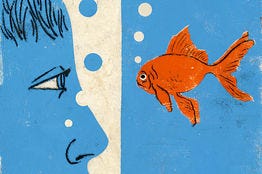Reframing pain, or why a fish needs water like you need Alexander Technique. Part 1
Finding Freedom from Pain: Lessons from Alexander Technique about why the most glaring and significant truths are often the hardest to notice.
This is by far my favourite David Foster Wallace story.
“There are these two young fish swimming along and they happen to meet an older fish swimming the other way, who nods at them and says “Morning, boys. How’s the water?” And the two young fish swim on for a bit, and then eventually one of them looks over at the other and goes “What the hell is water?”
The essence of the fish story is that the most glaring and significant truths are often the hardest to notice.
You're probably aware of how tough it is to focus on the things that really matter, rather than getting too caught up in your pain or internal chatter (which might be happening right now). In the trenches of dealing with persistent pain, managing your attention is often a challenge.
Real freedom from pain happens once you can effortlessly switch your attention from the pain stimulus to your pain relief strategies. You can learn this and move towards vitality and health in a pain-free body.
Alexander Technique has been teaching how to do this for over a century. It is mindfulness applied to movement. Although frequently used by elite performers in acting, music and sport, most use it to get out of pain. It’s a clinically proven way of undoing harmful muscle patterning. It works fast, with many experiencing immediate relief.
More than just another movement system or treatment, it's another way of thinking. It is often the missing piece in restoring a healthy, functional body. Alexander Technique teachers have refined the precise instructions that best improve muscle tone, postural support and coordination so that you have the freedom to move without tension and bracing.
Before you get there, there is an essential stage of getting to know yourself well in all your discomfort.
Unraveling Stress and Tension in Everyday Tasks
Imagine yourself engaged with a recent stressful situation in your work or life. When you’ve picked one, how about attempting a movement that triggers tension or pain? For me, the two often come hand in hand as I’m stressing to get some computer work done whilst straining my body at the computer. Whilst you do this, there's no need to overly push yourself, but rather explore it within your own limits, observing what arises in your mind as you do this. You can put yourself into the same shape or posture you would be when doing this activity and see what you find.
What’s going on when you repeat this movement over and over whilst imagining that stressful situation? Is any of this happening?
Muscles tighten, pain starts, breath becomes shallow.
You distract yourself from the pain and stay focused on the task or screen.
You keep distracting yourself until pain grabs your attention.
You steer your attention away from the pain and back towards the task at hand, perhaps saying something reassuring to yourself about the pain.
The pain gets worse so you distract yourself. You place your awareness anywhere but the pain, anywhere but your body, which now feels separate, pushed away. You’ve become disembodied.
You’ve excluded the painful area from your awareness. For a while, at least.
Then, you focus on it. Awareness of everything else diminishes - the rest of your body, the outside world.
You brace against the pain. Movement is more strained and tense. Pain increases.
During concentration, you frown and tense your face.
You’re becoming hypervigilant. Thought loops start in your head.
Ow! Stop! Ow! Stop! Ow! When will this stop? Will it ever stop? Ow! Will it get worse? Is this more serious than I think? Ow!
Being in pain is exhausting. Does any of this sound familiar?
Throughout the day, your attention oscillates between distraction, thought loops and over-focusing. When you’re busily engaged in something else, you feel less pain. Conversely, the more you focus on your pain, the worse it feels. The more you then resist it, the more you want it to go away, the more you suffer.
Feeling down, anxious, or stressed about the pain too? Expect heightened pain, as neural pathways for pain intertwine with emotion centers, especially fear. Whether it's common worries like "Will this get worse?" or less frequent concerns about work and bills, these fears subtly shape your emotional state and pain experience.
When I was in crippling pain, every treatment I tried failed. The pain persisted, but I refused to settle for merely managing it. Treating symptoms didn't feel like a solution. I was determined to identify and fix the root causes of my pain. It turns out that I’m not alone. So many of us have:
Injuries that have not been addressed with rehabilitation or are getting worse
Sedentary lifestyles or workplaces
Recurring wear and tear from repetitive day-to-day movements
Part 2 will explore more about the skill of recognising how the water is in your body and mind, and effortlessly shifting your awareness to have the freedom to move.
Until next time.


